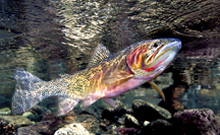Influences on hybridization between native and invasive fish
 Evolutionary Bio,
Evolutionary Bio,  Fish,
Fish,  Freshwater,
Freshwater,  Invasive
Invasive  Westslope cutthroat. Image credit, Pat Clayton, www.fisheyeguyphotography.com.
Westslope cutthroat. Image credit, Pat Clayton, www.fisheyeguyphotography.com.
Hybridization threatening native species...
In a new study, scientists have looked at what factors influence the hybridization between native westslope cutthroat (Oncorhynchus clarki lewisi) and the exotic rainbow trout (Oncorhynchus mykiss) in western North America. The introduced rainbow trout has interbreed extensively with the cutthroat, and today the non-hybridized native fish exists in less than 10% of its former range in the United States and less than 20% in Canada.
Hybridization between invasive and native species has emerged as an issue of major ecological concern. Among freshwater fish in North America, interbreeding between native and introduced species is considered a leading cause in the decline and extinction of many species.
Past research has found that a variety of factors such as water temperature, stream connectivity, and proximity to native species can influence the success of exotic fish invasion of streams. However, fewer studies have looked at what biotic and abiotic factors affect the spread of hybridization of native and exotic fish species.
In a new study, the researchers looked at the relationship between the spread of hybridization and factors such as local habitat features (width, gradient, and elevation), watershed characteristics (mean and maximum summer water temperatures, the number of road crossings, and road density), and biotic factors (the distance to the source of hybridization and trout density). They conducted the study in the Upper Flathead river system in Montana and British Columbia - a remaining stronghold of non-hybridized westslope cutthroats.
The researchers collected fish population and habitat data from 35 sites in the river system. They found that the occurrence of hybridized trout was positively associated with mean summer water temperature and the number of upstream road crossings and negatively associated with the distance to the source of hybridization. The study also looked at the proportion of rainbow trout genetic admixture present in hybridized fish and found that it was negatively related to distance to the source of hybridization and positively related to mean temperature and density. According to the researchers,
"Our results provide evidence supporting the hypothesis that hybridization is more likely to occur and spread in streams with warm water temperatures, increased land use disturbance, and proximity to the main source of hybridization. Our findings provide fisheries managers with a better understanding of the factors that promote the success of invasions and the loss of biodiversity through extinction by hybridization."
The researchers recommend that in order to preserve non-hybridized westslope cutthroat trout populations, resource managers should consider eradicating hybridized populations with high levels of rainbow trout admixture and restoring streams characterized by warm temperatures and high levels of disturbance.
| Source: | Transactions of the American Fisheries Society |
| Title: | Local Habitat, Watershed, and Biotic Factors Influencing the Spread of Hybridization between Native Westslope Cutthroat Trout and Introduced Rainbow Trout |
| Authors: | a) Clint Muhlfeld, b) Thomas McMahon, c Matthew Boyer, and a) Robert Gresswell |
| a) US Geological Service, b) Montana State University, c) Montan, Fish, Wildlife and Parks |




Reader Comments